This site uses cookies as defined in our Cookie Policy, by continuing to use this site you agree to their use.
Continue
| Arrive | Depart | ||||||
| 2nd02 | JunJun | 202727 | Fusina, Italy, embark on the Seven Seas Grandeur | 07:00 | 17:00 | ||
| 3rd03 | JunJun | 202727 | Split, Croatia | 10:00 | 18:00 | ||
Split's ancient core is so spectacular and unusual that a visit is more than worth your time. The heart of the city lies within the walls of Roman emperor Diocletian's retirement palace, which was built in the 3rd century AD. Diocletian, born in the nearby Roman settlement of Salona in AD 245, achieved a brilliant career as a soldier and became emperor at the age of 40. In 295 he ordered this vast palace to be built in his native Dalmatia, and when it was completed he stepped down from the throne and retired to his beloved homeland. Upon his death, he was laid to rest in an octagonal mausoleum, around which Split's magnificent cathedral was built.In 615, when Salona was sacked by barbarian tribes, those fortunate enough to escape found refuge within the stout palace walls and divided up the vast imperial apartments into more modest living quarters. Thus, the palace developed into an urban center, and by the 11th century the settlement had expanded beyond the ancient walls.Under the rule of Venice (1420–1797), Split—as a gateway to the Balkan interior—became one of the Adriatic's main trading ports, and the city's splendid Renaissance palaces bear witness to the affluence of those times. When the Habsburgs took control during the 19th century, an overland connection to Central Europe was established by the construction of the Split–Zagreb–Vienna railway line.After World War II, the Tito years saw a period of rapid urban expansion: industrialization accelerated and the suburbs extended to accommodate high-rise apartment blocks. Today the historic center of Split is included on UNESCO's list of World Heritage Sites. | |||||||
| 4th04 | JunJun | 202727 | Dubrovnik, Croatia | 07:00 | 16:00 | ||
Nothing can prepare you for your first sight of Dubrovnik. Lying 216 km (135 miles) southeast of Split and commanding a jaw-dropping coastal location, it is one of the world's most beautiful fortified cities. Its massive stone ramparts and fortress towers curve around a tiny harbor, enclosing graduated ridges of sun-bleached orange-tiled roofs, copper domes, and elegant bell towers. Your imagination will run wild picturing what it looked like seven centuries ago when the walls were built, without any suburbs or highways around it, just this magnificent stone city rising out of the sea.In the 7th century AD, residents of the Roman city Epidaurum (now Cavtat) fled the Avars and Slavs of the north and founded a new settlement on a small rocky island, which they named Laus, and later Ragusa. On the mainland hillside opposite the island, the Slav settlement called Dubrovnik grew up. In the 12th century the narrow channel separating the two settlements was filled in (now the main street through the Old Town, called Stradun), and Ragusa and Dubrovnik became one. The city was surrounded by defensive walls during the 13th century, and these were reinforced with towers and bastions in the late 15th century.From 1358 to 1808 the city thrived as a powerful and remarkably sophisticated independent republic, reaching its golden age during the 16th century. In 1667 many of its splendid Gothic and Renaissance buildings were destroyed by an earthquake. The defensive walls survived the disaster, and the city was rebuilt in baroque style.Dubrovnik lost its independence to Napoléon in 1808, and in 1815 passed to Austria-Hungary. During the 20th century, as part of Yugoslavia, the city became a popular tourist destination, and in 1979 it was listed as a UNESCO World Heritage Site. During the war for independence, it came under heavy siege. Thanks to careful restoration, few traces of damage remain; however, there are maps inside the Pile and Ploče Gates illustrating the points around the city where damage was done. It’s only when you experience Dubrovnik yourself that you can understand what a treasure the world nearly lost | |||||||
| 5th05 | JunJun | 202727 | Corfu, Greece | 08:00 | 17:00 | ||
Corfu town today is a vivid tapestry of cultures—a sophisticated weave, where charm, history, and natural beauty blend. Located about midway along the island's east coast, this spectacularly lively capital is the cultural heart of Corfu and has a remarkable historic center that UNESCO designated as a World Heritage Site in 2007. All ships and planes dock or land near Corfu town, which occupies a small peninsula jutting into the Ionian Sea.Whether arriving by ferry from mainland Greece or Italy, from another island, or directly by plane, catch your breath by first relaxing with a coffee or a gelato in Corfu town's shaded Liston Arcade, then stroll the narrow lanes of its pedestrians-only quarter. For an overview of the immediate area, and a quick tour of Mon Repos palace, hop on the little tourist train that runs from May to September. Corfu town has a different feel at night, so book a table at one of its famed tavernas to savor the island's unique cuisine.The best way to get around Corfu town is on foot. The town is small enough so that you can easily walk to every sight. There are local buses, but they do not thread their way into the streets (many now car-free) of the historic center. If you are arriving by ferry or plane, it's best to take a taxi to your hotel. Expect to pay about €10 from the airport or ferry terminal to a hotel in Corfu town. If there are no taxis waiting, you can call for one. | |||||||
| 6th06 | JunJun | 202727 | Argostoli, Greece | 07:00 | 16:00 | ||
Ground literally to ashes in World War II and wracked by a massive earthquake a decade later, the capital of Kefalonia once more shows pride in its native spirit and natural beauty. The vast harbor on Argostoli’s east side makes an especially attractive port for cruise ships full of visitors who never seem to tire of strolling the cobbled seaside promenade, sipping ouzos in cafés, and stocking up on the succulent Mediterranean fruits in the outdoor markets. | |||||||
| 7th07 | JunJun | 202727 | Monemvasía, Greece | 08:00 | 18:00 | ||
Monemvasia boasts a varied and colorful history that can be traced to the 8th-century when Greeks fleeing the Slav invasion of Lakonia found refuge here. In its heyday it controlled sea travel between the Levant and European shores. The wall-encircled Lower Town extends along the slopes of a 985-foot-high crag that projects into the sea on the east side of the Peloponnese. For centuries an impressive stronghold, population dwindled as the inhabitants moved to the mainland. But with the beginning of a restoration program aimed to preserve Monemvasia's heritage, the Lower Town experienced a new lease on life, and people have begun to return. The Upper Town is situated on top of the Rock of Monemvasia. It is reached via a zigzagging, paved lane. An almost impregnable bastion in earlier days, it has been uninhabited for centuries, but still manages to preserve its magnificent appearance. Visitors today can explore the remains of the ancient citadel-castle and visit the church of Hagia Sofia. From the summit there is also a fantastic view of the surrounding area. | |||||||
| 8th08 | JunJun | 202727 | Piraeus, Greece | 05:30 | 19:00 | ||
It's no wonder that all roads lead to the fascinating and maddening metropolis of Athens. Lift your eyes 200 feet above the city to the Parthenon, its honey-color marble columns rising from a massive limestone base, and you behold architectural perfection that has not been surpassed in 2,500 years. But, today, this shrine of classical form dominates a 21st-century boomtown. To experience Athens—Athína in Greek—fully is to understand the essence of Greece: ancient monuments surviving in a sea of cement, startling beauty amid the squalor, tradition juxtaposed with modernity. Locals depend on humor and flexibility to deal with the chaos; you should do the same. The rewards are immense. Although Athens covers a huge area, the major landmarks of the ancient Greek, Roman, and Byzantine periods are close to the modern city center. You can easily walk from the Acropolis to many other key sites, taking time to browse in shops and relax in cafés and tavernas along the way. From many quarters of the city you can glimpse "the glory that was Greece" in the form of the Acropolis looming above the horizon, but only by actually climbing that rocky precipice can you feel the impact of the ancient settlement. The Acropolis and Filopappou, two craggy hills sitting side by side; the ancient Agora (marketplace); and Kerameikos, the first cemetery, form the core of ancient and Roman Athens. Along the Unification of Archaeological Sites promenade, you can follow stone-paved, tree-lined walkways from site to site, undisturbed by traffic. Cars have also been banned or reduced in other streets in the historical center. In the National Archaeological Museum, vast numbers of artifacts illustrate the many millennia of Greek civilization; smaller museums such as the Goulandris Museum of Cycladic Art Museum and the Byzantine and Christian Museum illuminate the history of particular regions or periods. Athens may seem like one huge city, but it is really a conglomeration of neighborhoods with distinctive characters. The Eastern influences that prevailed during the 400-year rule of the Ottoman Empire are still evident in Monastiraki, the bazaar area near the foot of the Acropolis. On the northern slope of the Acropolis, stroll through Plaka (if possible by moonlight), an area of tranquil streets lined with renovated mansions, to get the flavor of the 19th-century's gracious lifestyle. The narrow lanes of Anafiotika, a section of Plaka, thread past tiny churches and small, color-washed houses with wooden upper stories, recalling a Cycladic island village. In this maze of winding streets, vestiges of the older city are everywhere: crumbling stairways lined with festive tavernas; dank cellars filled with wine vats; occasionally a court or diminutive garden, enclosed within high walls and filled with magnolia trees and the flaming trumpet-shaped flowers of hibiscus bushes. Formerly run-down old quarters, such as Thission, Gazi and Psirri, popular nightlife areas filled with bars and mezedopoleia (similar to tapas bars), are now in the process of gentrification, although they still retain much of their original charm, as does the colorful produce and meat market on Athinas. The area around Syntagma Square, the tourist hub, and Omonia Square, the commercial heart of the city about 1 km (½ mi) northwest, is distinctly European, having been designed by the court architects of King Otho, a Bavarian, in the 19th century. The chic shops and bistros of ritzy Kolonaki nestle at the foot of Mt. Lycabettus, Athens's highest hill (909 feet). Each of Athens's outlying suburbs has a distinctive character: in the north is wealthy, tree-lined Kifissia, once a summer resort for aristocratic Athenians, and in the south and southeast lie Glyfada, Voula, and Vouliagmeni, with their sandy beaches, seaside bars, and lively summer nightlife. Just beyond the city's southern fringes is Piraeus, a bustling port city of waterside fish tavernas and Saronic Gulf views. | |||||||
| 9th09 | JunJun | 202727 | At Sea | ||||
| 10th10 | JunJun | 202727 | Valletta, Malta | 07:00 | 16:00 | ||
Malta's capital, the minicity of Valletta, has ornate palaces and museums protected by massive fortifications of honey-color limestone. Houses along the narrow streets have overhanging wooden balconies for people-watching from indoors. Generations ago they gave housebound women a window on the world of the street. The main entrance to town is through the City Gate (where all bus routes end), which leads onto Triq Repubblika (Republic Street), the spine of the grid-pattern city and the main shopping street. Triq Mercante (Merchant Street) parallels Repubblika to the east and is also good for strolling. From these two streets, cross streets descend toward the water; some are stepped. Valletta's compactness makes it ideal to explore on foot. City Gate and the upper part of Valletta are experiencing vast redevelopment that includes a new Parliament Building and open-air performance venue. The complex, completed mid-2013, has numerous pedestrian detours in place along with building noise and dust. Before setting out along Republic Street, stop at the tourist information office on Merchant Street for maps and brochures. | |||||||
| 11th11 | JunJun | 202727 | At Sea | ||||
| 12th12 | JunJun | 202727 | Palma de Mallorca, Spain | 09:00 | 18:00 | ||
If you look north of the cathedral (La Seu, or the seat of the bishopric, to Mallorcans) on a map of the city of Palma, you can see around the Plaça Santa Eulàlia a jumble of tiny streets that made up the earliest settlement. Farther out, a ring of wide boulevards traces the fortifications built by the Moors to defend the larger city that emerged by the 12th century. The zigzags mark the bastions that jutted out at regular intervals. By the end of the 19th century, most of the walls had been demolished; the only place where you can still see the massive defenses is at Ses Voltes, along the seafront west of the cathedral.A torrent (streambed) used to run through the middle of the old city, dry for most of the year but often a raging flood in the rainy season. In the 17th century it was diverted to the east, along the moat that ran outside the city walls. Two of Palma's main arteries, La Rambla and the Passeig d'es Born, now follow the stream's natural course. The traditional evening paseo (promenade) takes place on the Born.If you come to Palma by car, park in the garage beneath the Parc de la Mar (the ramp is just off the highway from the airport, as you reach the cathedral) and stroll along the park. Beside it run the huge bastions guarding the Almudaina Palace; the cathedral, golden and massive, rises beyond. Where you exit the garage, there's a ceramic mural by the late Catalan artist and Mallorca resident Joan Miró, facing the cathedral across the pool that runs the length of the park.If you begin early enough, a walk along the ramparts at Ses Voltes from the mirador beside the cathedral is spectacular. The first rays of the sun turn the upper pinnacles of La Seu bright gold and then begin to work their way down the sandstone walls. From the Parc de la Mar, follow Avinguda Antoni Maura past the steps to the palace. Just below the Plaça de la Reina, where the Passeig d'es Born begins, turn left on Carrer de la Boteria into the Plaça de la Llotja (if the Llotja itself is open, don't miss a chance to visit—it's the Mediterranean's finest Gothic-style civic building). From there stroll through the Plaça Drassana to the Museu d'Es Baluard, at the end of Carrer Sant Pere. Retrace your steps to Avinguda Antoni Maura. Walk up the Passeig d'es Born to Plaça Joan Carles I, then right on Avenida de La Unió. | |||||||
| 13th13 | JunJun | 202727 | Barcelona, Spain | 07:00 | 17:00 | ||
The infinite variety of street life, the nooks and crannies of the medieval Barri Gòtic, the ceramic tile and stained glass of Art Nouveau facades, the art and music, the throb of street life, the food (ah, the food!)—one way or another, Barcelona will find a way to get your full attention. The capital of Catalonia is a banquet for the senses, with its beguiling mix of ancient and modern architecture, tempting cafés and markets, and sun-drenched Mediterranean beaches. A stroll along La Rambla and through waterfront Barceloneta, as well as a tour of Gaudí's majestic Sagrada Famíliaand his other unique creations, are part of a visit to Spain's second-largest city. Modern art museums and chic shops call for attention, too. Barcelona's vibe stays lively well into the night, when you can linger over regional wine and cuisine at buzzing tapas bars. | |||||||
| 14th14 | JunJun | 202727 | Palamós, Spain | 08:00 | 17:00 | ||
One of the best ways to arrive in Catalonia is by sea, especially via the Costa Brava. This coastline, also known as the Rugged or Wild Coast, stretches from Blanes to the French border. Its name aptly refers to the steep cliff of ancient twisted rocks, which runs its entire length and is bounded inland by the Catalan mountain ranges. The intensity of the coast’s colour, the ruggedness of the rocks and the scent of the plants all combine to add to its attraction. The history of this region is long and varied. Traces can be found of the advanced culture of the Iberians, Greeks, Romans, Visigoths and Arabs. With Wilfred I and the independence of Catalan countries, the Catalan dynasty was born. Later, in 1479, Catalonia became a part of unified Spain following the marriage of Isabel, Queen of Castile, and Fernando, King of Aragon. The port of Palamos, some 36 miles northeast of Barcelona, has been in existence for nearly 700 years thanks to its location on one of the deepest natural bays in the western Mediterranean. The town itself is the southernmost of a series of resorts popular with sun worshippers. For the most part, Palamos has managed to retain some of the charm of a fishing village. The port also serves as a gateway to such inland locations as Girona, the capital of the province. Art lovers may want to visit Figueras, famous for its bizarre Teatre-Museu Dali, the foremost of a series of sites associated with the eccentric surrealist artist, Salvador Dali. If you choose to stay in Palamos, you can enjoy the pleasant atmosphere of the town or spend some time at a nearby beach. The town has a long seagoing tradition and busy harbour. The fish auction, prompted by the arrival of the fishing boats, is a spectacle worth seeing. The Fishing Museum illustrates the history and the life of the families who live off the sea. | |||||||
| 15th15 | JunJun | 202727 | Cannes, France | 08:00 | 17:00 | ||
Cannes is pampered with the luxurious year-round climate that has made it one of the most popular resorts in Europe. Cannes was an important sentinel site for the monks who established themselves on Île St-Honorat in the Middle Ages. Its bay served as nothing more than a fishing port until in 1834 an English aristocrat, Lord Brougham, fell in love with the site during an emergency stopover with a sick daughter. He had a home built here and returned every winter for a sun cure—a ritual quickly picked up by his peers. Between the popularity of Le Train Blue transporting wealthy passengers from Calais, and the introduction in 1936 of France's first paid holidays, Cannes became the destination, a tasteful and expensive breeding ground for the upper-upscale.Cannes has been further glamorized by the ongoing success of its annual film festival, as famous as Hollywood's Academy Awards. About the closest many of us will get to feeling like a film star is a stroll here along La Croisette, the iconic promenade that gracefully curves the wave-washed sand coastline, peppered with chic restaurants and prestigious private beaches. This is precisely the sort of place for which the French invented the verb flâner (to dawdle, saunter): strewn with palm trees and poseurs, its fancy boutiques and status-symbol grand hotels—including the Carlton, the legendary backdrop to Grace Kelly in To Catch a Thief —all vying for the custom of the Louis Vuitton set. This legend is, to many, the heart and soul of the Côte d'Azur. | |||||||
| 16th16 | JunJun | 202727 | Monaco, Monaco | 08:00 | 17:00 | ||
The 202-hectare Principality of Monaco is located east of France’s Mediterranean coast. Known for its royal family, especially Prince Albert of Monaco, its casinos and racetracks and for being a wealthy state with no applied taxes. Monaco is reachable by air through the French airport of Nice Côte d'Azur, located approximately 16 miles from the principality. | |||||||
| 17th17 | JunJun | 202727 | At Sea | ||||
| 18th18 | JunJun | 202727 | Portofino, Italy | 08:00 | 17:00 | ||
One of the most photographed villages along the coast, with a decidedly romantic and affluent aura, Portofino has long been a popular destination for the rich and famous. Once an ancient Roman colony and taken by the Republic of Genoa in 1229, it’s also been ruled by the French, English, Spanish, and Austrians, as well as by marauding bands of 16th-century pirates. Elite British tourists first flocked to the lush harbor in the mid-1800s. Some of Europe's wealthiest drop anchor in Portofino in summer, but they stay out of sight by day, appearing in the evening after buses and boats have carried off the day-trippers.There's not actually much to do in Portofino other than stroll around the wee harbor, see the castle, walk to Punta del Capo, browse at the pricey boutiques, and sip a coffee while people-watching. However, weaving through picture-perfect cliffside gardens and gazing at yachts framed by the sapphire Ligurian Sea and the cliffs of Santa Margherita can make for quite a relaxing afternoon. There are also several tame, photo-friendly hikes into the hills to nearby villages.Unless you're traveling on a deluxe budget, you may want to stay in Camogli or Santa Margherita Ligure rather than at one of Portofino's few very expensive hotels. Restaurants and cafés are good but also pricey (don't expect to have a beer here for much under €10). | |||||||
| 19th19 | JunJun | 202727 | Livorno, Italy | 07:00 | 19:00 | ||
Livorno is a gritty city with a long and interesting history. In the early Middle Ages it alternately belonged to Pisa and Genoa. In 1421 Florence, seeking access to the sea, bought it. Cosimo I (1519–74) started construction of the harbor in 1571, putting Livorno on the map. After Ferdinando I de' Medici (1549–1609) proclaimed Livorno a free city, it became a haven for people suffering from religious persecution; Roman Catholics from England and Jews and Moors from Spain and Portugal, among others, settled here. The Quattro Mori (Four Moors), also known as the Monument to Ferdinando I, commemorates this. (The statue of Ferdinando I dates from 1595, the bronze Moors by Pietro Tacca from the 1620s.)In the following centuries, and particularly in the 18th, Livorno boomed as a port. In the 19th century the town drew a host of famous Britons passing through on their grand tours. Its prominence continued up to World War II, when it was heavily bombed. Much of the town's architecture, therefore, postdates the war, and it's somewhat difficult to imagine what it might have looked like before. Livorno has recovered from the war, however, as it's become a huge point of departure for container ships, as well as the only spot in Tuscany for cruise ships to dock for the day.Most of Livorno's artistic treasures date from the 17th century and aren't all that interesting unless you dote on obscure baroque artists. Livorno's most famous native artist, Amedeo Modigliani (1884–1920), was of much more recent vintage. Sadly, there's no notable work by him in his hometown.There may not be much in the way of art, but it's still worth strolling around the city. The Mercato Nuovo, which has been around since 1894, sells all sorts of fruits, vegetables, grains, meat, and fish. Outdoor markets nearby are also chock-full of local color. The presence of Camp Darby, an American military base just outside town, accounts for the availability of many American products.If you have time, Livorno is worth a stop for lunch or dinner at the very least. | |||||||
| 20th20 | JunJun | 202727 | Civitavecchia, Italy, disembark the Seven Seas Grandeur | 07:00 | |||
Italy's vibrant capital lives in the present, but no other city on earth evokes its past so powerfully. For over 2,500 years, emperors, popes, artists, and common citizens have left their mark here. Archaeological remains from ancient Rome, art-stuffed churches, and the treasures of Vatican City vie for your attention, but Rome is also a wonderful place to practice the Italian-perfected il dolce far niente, the sweet art of idleness. Your most memorable experiences may include sitting at a caffè in the Campo de' Fiori or strolling in a beguiling piazza. | |||||||
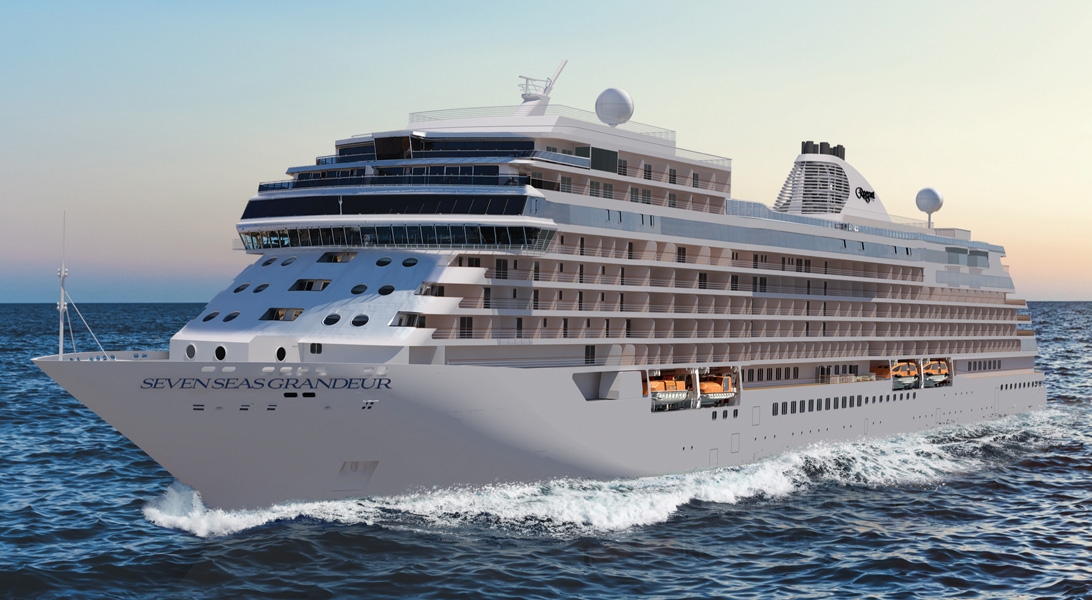










The images shown are for illustration purposes only and may not be an exact representation of what you find on the ship.
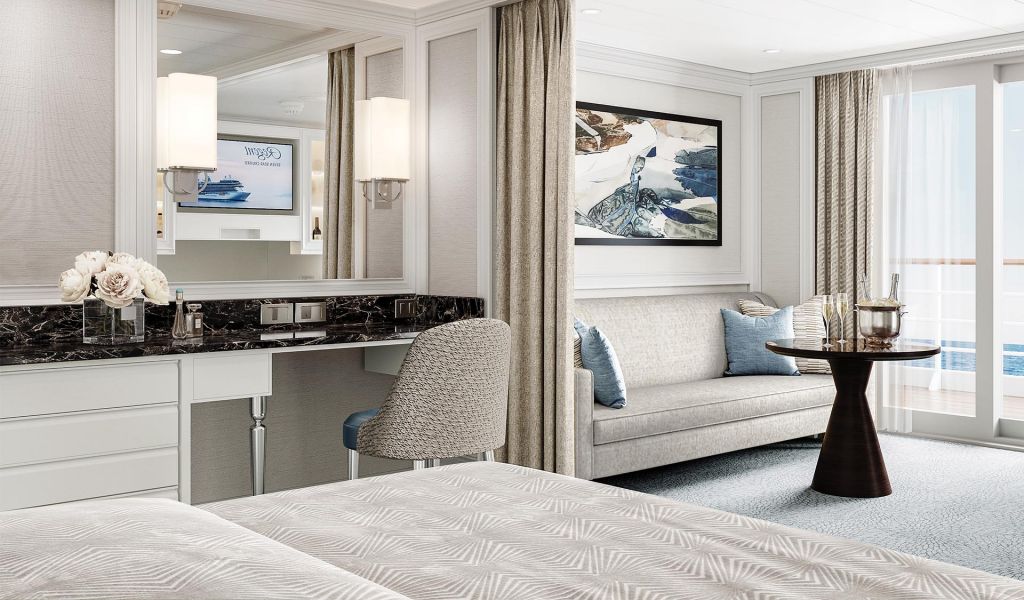
| Grade Code | From | To | |
| E | Concierge Suite | £12,999 | £16,099 |
| D | Concierge Suite | £13,539 | £16,639 |
Step out onto your private balcony with a freshly made cup of coffee and take in the grandeur of ocean travel. This suite is packed with stylish comfort and includes a king-sized bed with a spectacular horizon view.
Layout
This category includes Accessibility Options in suites 822 and 823. For more information about accessible suites click here.
Amenities
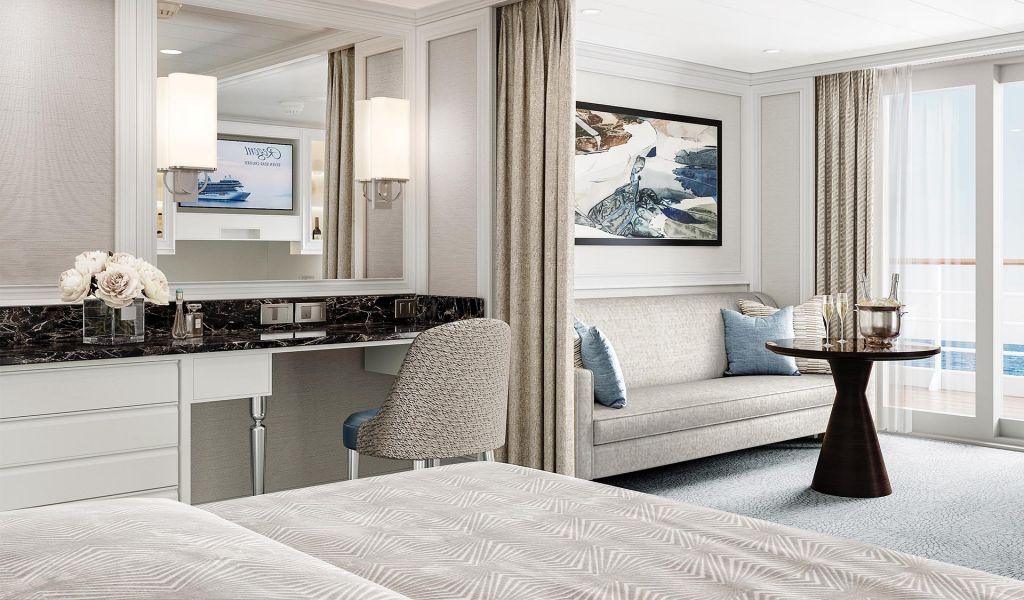
| Grade Code | From | To | |
| G2 | Deluxe Veranda Suite | £11,079 | £14,179 |
| G1 | Deluxe Veranda Suite | £11,389 | £14,489 |
First, the view — soak in the entirety of your ocean-going adventure out on your private balcony, or get cozy in your floor-to-ceiling-windowed sitting area. Inside is perfectly designed for maximum elegance and comfort.
Layout
Amenities
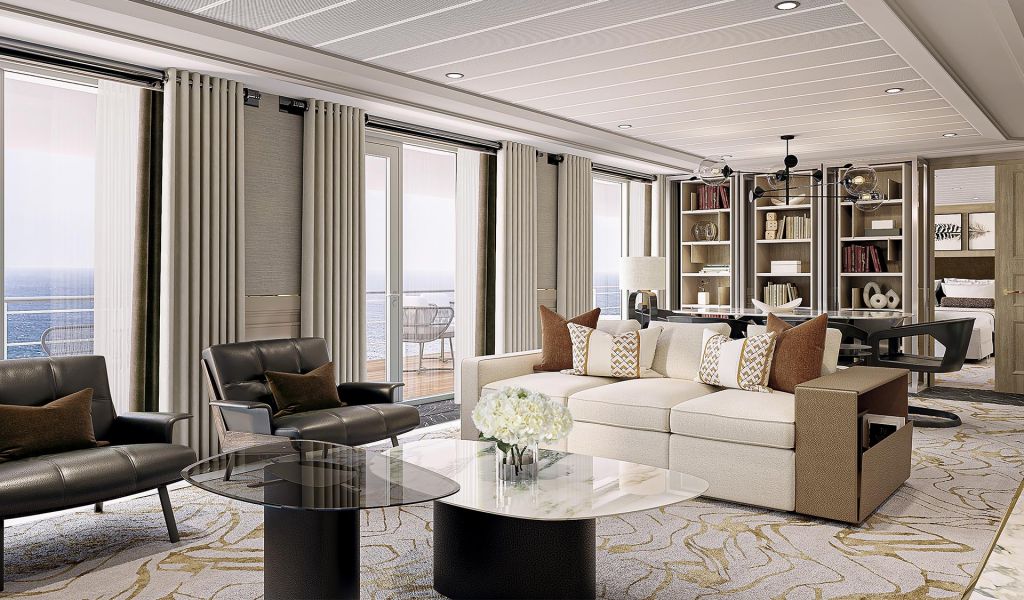
| Grade Code | From | To | |
| GS | Grand Suite | £26,539 | £29,639 |
Experience the joy of sailing the world with an exquisitely designed space like this suite to call home throughout your voyage. Indulge in a sumptuous living room, two full baths, lavish bath products and a private balcony.
The suite pictured may differ from the suite booked, as layouts and designs vary by ship, deck, and suite location.
Layout
Amenities
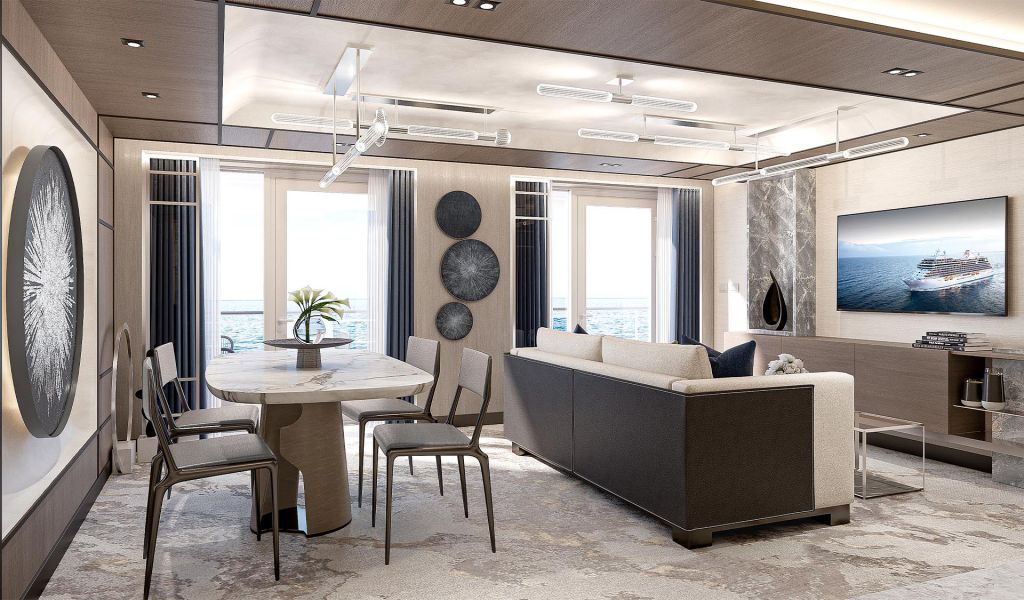
| Grade Code | From | To | |
| GN | Grandeur Suite | £23,849 | £26,949 |
A glamorous home away from home with a private balcony that’s among the largest at sea. Luxuriate in its spacious living room and sitting area, and impress guests with a full-liquor bar and in-suite caviar service.
Layout
Amenities
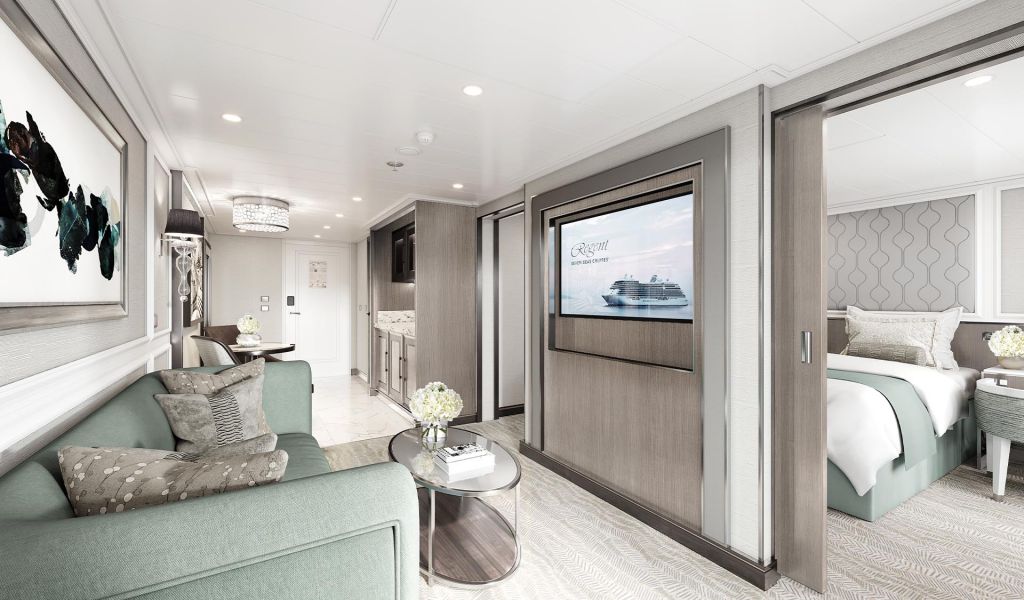
| Grade Code | From | To | |
| C | Penthouse Suite | £16,699 | £19,799 |
| B | Penthouse Suite | £17,389 | £20,489 |
| A | Penthouse Suite | £17,999 | £21,099 |
Designed to maximiSe your space and comfort — highlighted by a beautifully furnished sitting area and private balcony — you'll relish time spent in this luxurious suite as you prepare for your next onshore adventure.
Layout
Amenities
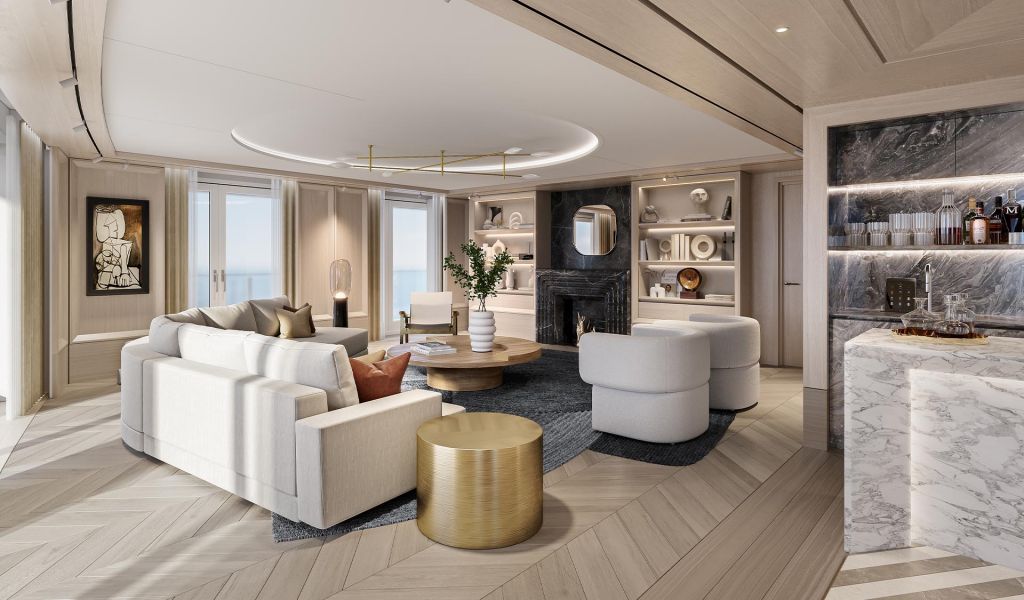
| Grade Code | From | To | |
| RS | Regent Suite | £103,849 | £106,949 |
A one-of-a-kind achievement in lavish accommodations, this unparalleled suite boasts an in-suite spa retreat, private balcony with a Treesse Minipool, two magnificent bedrooms and more. Simply astonishing luxury.
Layout
Amenities
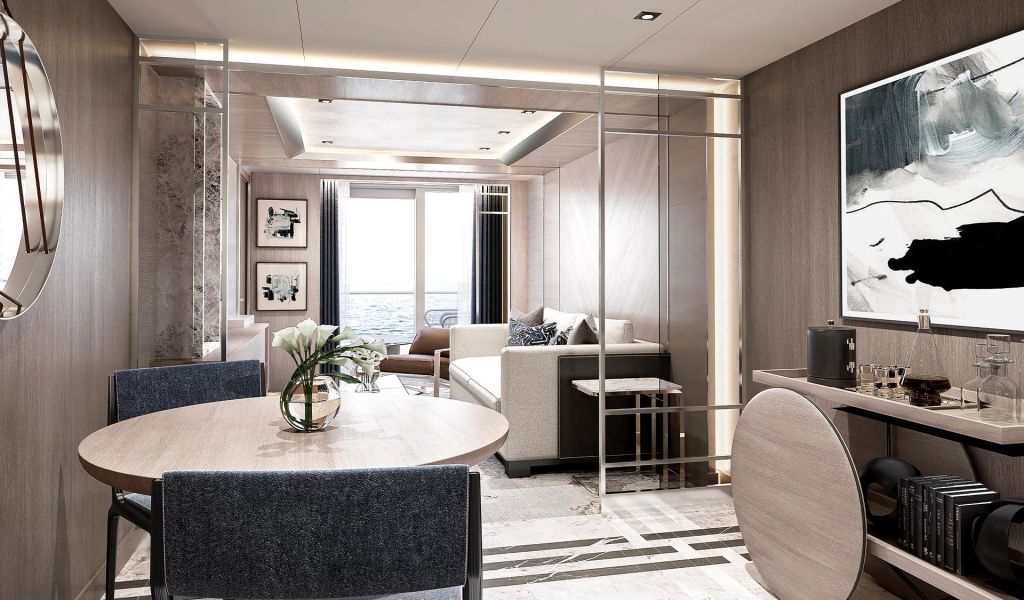
| Grade Code | From | To | |
| SS | Seven Seas Suite | £21,849 | £24,949 |
With glorious vistas in every direction, this suite is designed to complement the soothing nature of the world outside. Your private balcony will beckon from your stylish sitting area, as will the marble accents of your baths.
Layout
Amenities
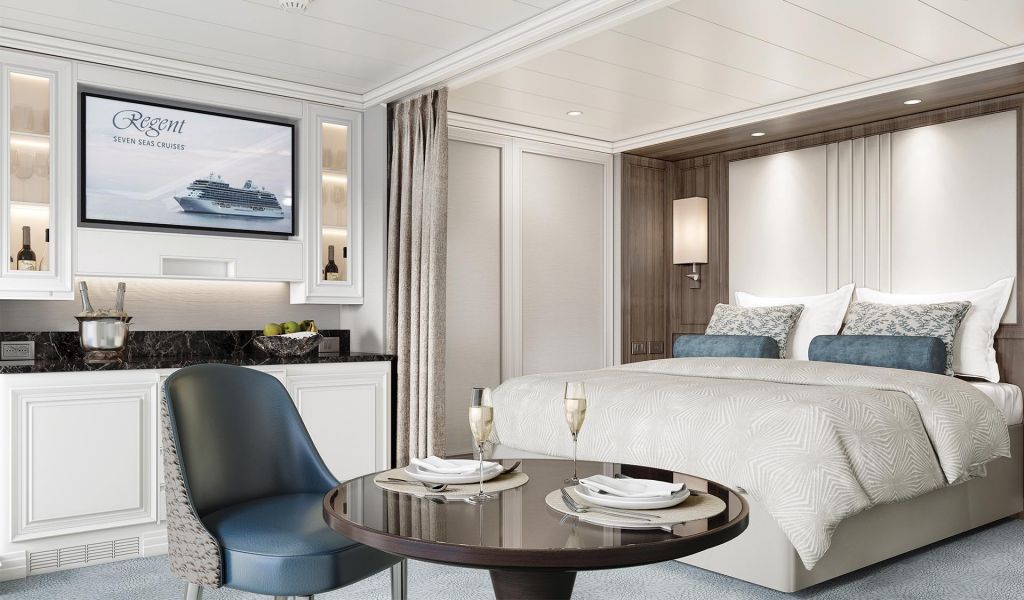
| Grade Code | From | To | |
| H | Veranda Suite | £10,539 | £13,639 |
A private balcony to sip the beverage of your choice, a sitting area with a table for in-suite breakfasts, lavish bath products, a flat-screen TV... this suite has all you need to feel spoiled on an unforgettable voyage.
Layout
Amenities
The images shown are for illustration purposes only and may not be an exact representation of what you find on the ship.
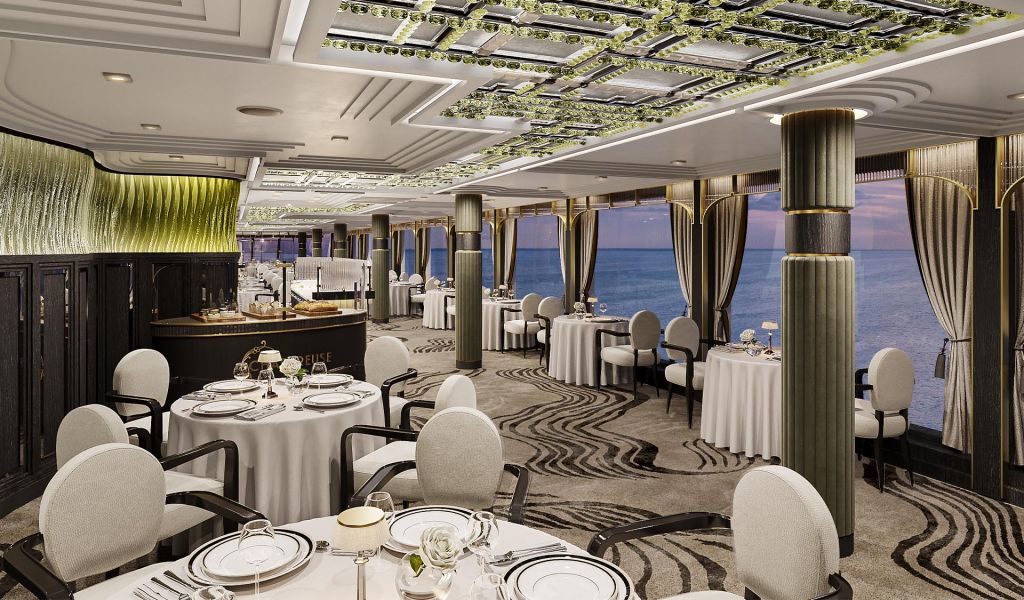
Classic French fare with a modern twist – and glorious ocean views. If Chartreuse seems familiar, you may have once stumbled upon a chic, fine-dining restaurant on a Champs-Elysees side street. A fantasy you can taste.

Our largest specialty restaurant on a ship full of spectacular dining options. Design your very own entrée from preferred sides, sauces, pastas and main features of beef, poultry and fish. Dessert? Decadent, of course.
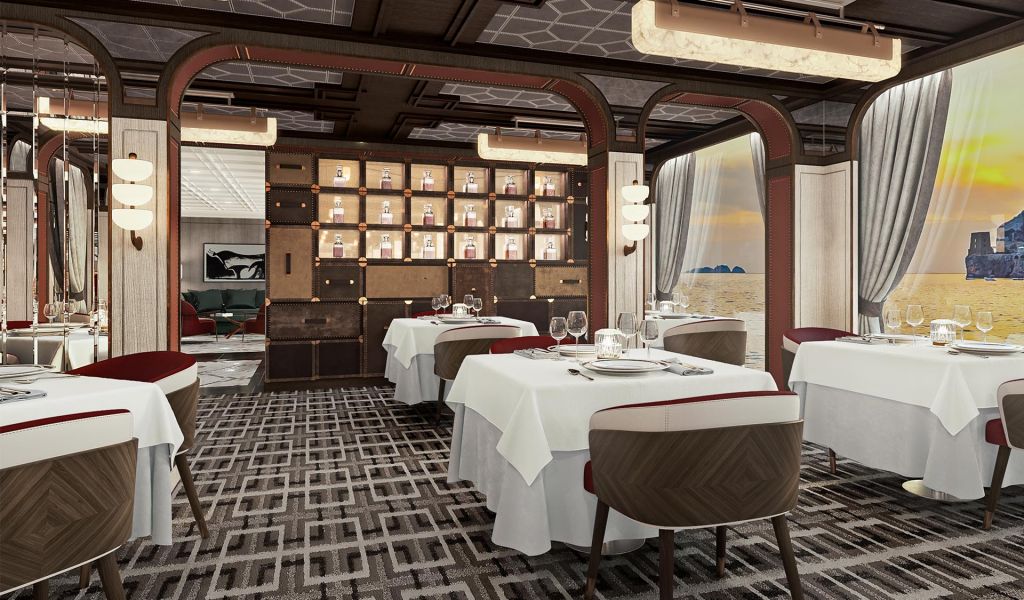
From perfectly aged New York strip, porterhouse and succulent filet mignon to smoked salmon with a phenomenal tamarind-whiskey sauce, Prime 7 elevates classic American fare to lofty heights.
The images shown are for illustration purposes only and may not be an exact representation of what you find on the ship.
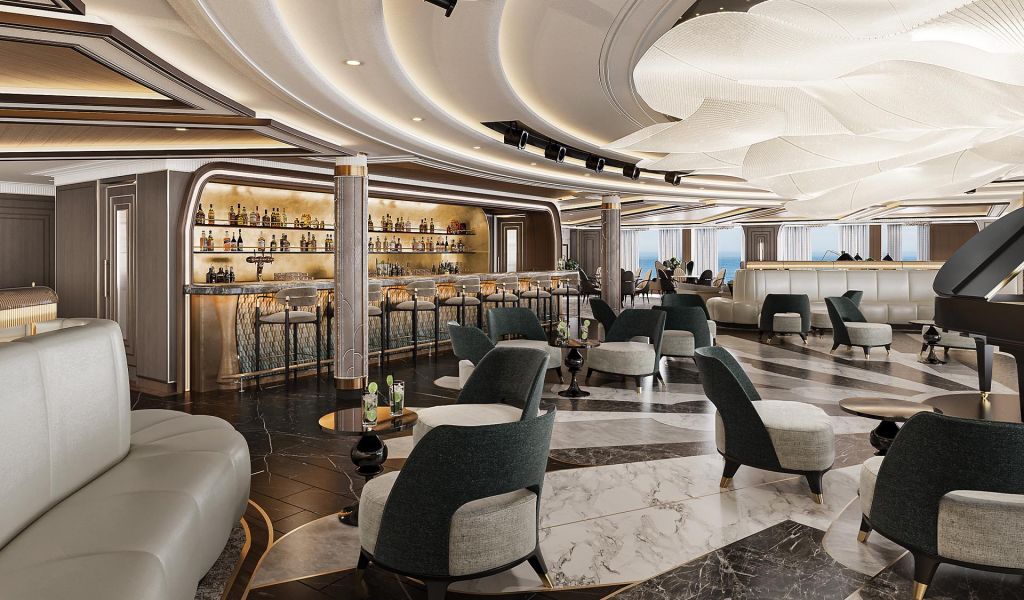
Every evening on Seven Seas Grandeur will be one to remember. As the lights go on from the stage to the dance floor, this stunning vessel takes on a new life with live productions, high-caliber musicians, guest entertainers, intimate lounges and more.
The images shown are for illustration purposes only and may not be an exact representation of what you find on the ship.
The images shown are for illustration purposes only and may not be an exact representation of what you find on the ship.
| Return flights including luggage allowance | |||
| Overseas Transfers | |||
| 18 nights aboard the Seven Seas Grandeur | |||
| Free Luxury Hotel Package in Concierge Suites and Higher | |||
| Free Unlimited Shore Excursions | |||
| Free Speciality Restaurants | |||
| Free Unlimited Beverages Including Fine Wines | |||
| Free In-Suite Mini Bar Replenished Daily | |||
| Free Pre-Paid Gratuities | |||
| Free Wifi Throughout the Ship | |||
| Free Transfers Between Airport and Ship | |||
| Free 24 Hour Room Service | |||
| Port Taxes and Fees | |||
 | ABTA and ATOL Protection* | ||
Fly/cruise package |
Date 2nd Jun 2027 |
Nts 18 |
Suite £10,539pp |
Suite £11,124pp |
Suite £11,124pp |
Suite £11,124pp |
Suite £11,124pp |
Suite £11,124pp |
Suite £11,124pp |
Suite £11,124pp |
Suite £11,124pp |
Suite £11,124pp |
Date 2nd Jun 2027 |
Nts 18 |
Suite £10,539pp |
Suite £11,124pp |
Suite £11,124pp |
Suite £11,124pp |
Suite £11,124pp |
Suite £11,124pp |
Suite £11,124pp |
Suite £11,124pp |
Suite £11,124pp |
Suite £11,124pp |
| Suite staterooms from | £10,539pp | ||
| RS | Regent Suite | £103,849pp | |
| GS | Grand Suite | £26,539pp | |
| GN | Grandeur Suite | £23,849pp | |
| SS | Seven Seas Suite | £21,849pp | |
| A | Penthouse Suite | £17,999pp | |
| B | Penthouse Suite | £17,389pp | |
| C | Penthouse Suite | £16,699pp | |
| D | Concierge Suite | £13,539pp | |
| E | Concierge Suite | £12,999pp | |
| F1 | Serenity Suite | £12,309pp | |
| F2 | Serenity Suite | £11,999pp | |
| G1 | Deluxe Veranda Suite | £11,389pp | |
| G2 | Deluxe Veranda Suite | £11,079pp | |
| H | Veranda Suite | £10,539pp | |
| SG | Signature Suite | £34,539pp | |
| Suite staterooms from | £11,124pp | ||
| RS | Regent Suite | £104,434pp | |
| GS | Grand Suite | £27,124pp | |
| GN | Grandeur Suite | £24,434pp | |
| SS | Seven Seas Suite | £22,434pp | |
| A | Penthouse Suite | £18,584pp | |
| B | Penthouse Suite | £17,974pp | |
| C | Penthouse Suite | £17,284pp | |
| D | Concierge Suite | £14,124pp | |
| E | Concierge Suite | £13,584pp | |
| F1 | Serenity Suite | £12,894pp | |
| F2 | Serenity Suite | £12,584pp | |
| G1 | Deluxe Veranda Suite | £11,974pp | |
| G2 | Deluxe Veranda Suite | £11,664pp | |
| H | Veranda Suite | £11,124pp | |
| SG | Signature Suite | £35,124pp | |
| Suite staterooms from | £11,124pp | ||
| RS | Regent Suite | £104,434pp | |
| GS | Grand Suite | £27,124pp | |
| GN | Grandeur Suite | £24,434pp | |
| SS | Seven Seas Suite | £22,434pp | |
| A | Penthouse Suite | £18,584pp | |
| B | Penthouse Suite | £17,974pp | |
| C | Penthouse Suite | £17,284pp | |
| D | Concierge Suite | £14,124pp | |
| E | Concierge Suite | £13,584pp | |
| F1 | Serenity Suite | £12,894pp | |
| F2 | Serenity Suite | £12,584pp | |
| G1 | Deluxe Veranda Suite | £11,974pp | |
| G2 | Deluxe Veranda Suite | £11,664pp | |
| H | Veranda Suite | £11,124pp | |
| SG | Signature Suite | £35,124pp | |
| Suite staterooms from | £11,124pp | ||
| RS | Regent Suite | £104,434pp | |
| GS | Grand Suite | £27,124pp | |
| GN | Grandeur Suite | £24,434pp | |
| SS | Seven Seas Suite | £22,434pp | |
| A | Penthouse Suite | £18,584pp | |
| B | Penthouse Suite | £17,974pp | |
| C | Penthouse Suite | £17,284pp | |
| D | Concierge Suite | £14,124pp | |
| E | Concierge Suite | £13,584pp | |
| F1 | Serenity Suite | £12,894pp | |
| F2 | Serenity Suite | £12,584pp | |
| G1 | Deluxe Veranda Suite | £11,974pp | |
| G2 | Deluxe Veranda Suite | £11,664pp | |
| H | Veranda Suite | £11,124pp | |
| SG | Signature Suite | £35,124pp | |
| Suite staterooms from | £11,124pp | ||
| RS | Regent Suite | £104,434pp | |
| GS | Grand Suite | £27,124pp | |
| GN | Grandeur Suite | £24,434pp | |
| SS | Seven Seas Suite | £22,434pp | |
| A | Penthouse Suite | £18,584pp | |
| B | Penthouse Suite | £17,974pp | |
| C | Penthouse Suite | £17,284pp | |
| D | Concierge Suite | £14,124pp | |
| E | Concierge Suite | £13,584pp | |
| F1 | Serenity Suite | £12,894pp | |
| F2 | Serenity Suite | £12,584pp | |
| G1 | Deluxe Veranda Suite | £11,974pp | |
| G2 | Deluxe Veranda Suite | £11,664pp | |
| H | Veranda Suite | £11,124pp | |
| SG | Signature Suite | £35,124pp | |
| Suite staterooms from | £11,124pp | ||
| RS | Regent Suite | £104,434pp | |
| GS | Grand Suite | £27,124pp | |
| GN | Grandeur Suite | £24,434pp | |
| SS | Seven Seas Suite | £22,434pp | |
| A | Penthouse Suite | £18,584pp | |
| B | Penthouse Suite | £17,974pp | |
| C | Penthouse Suite | £17,284pp | |
| D | Concierge Suite | £14,124pp | |
| E | Concierge Suite | £13,584pp | |
| F1 | Serenity Suite | £12,894pp | |
| F2 | Serenity Suite | £12,584pp | |
| G1 | Deluxe Veranda Suite | £11,974pp | |
| G2 | Deluxe Veranda Suite | £11,664pp | |
| H | Veranda Suite | £11,124pp | |
| SG | Signature Suite | £35,124pp | |
| Suite staterooms from | £11,124pp | ||
| RS | Regent Suite | £104,434pp | |
| GS | Grand Suite | £27,124pp | |
| GN | Grandeur Suite | £24,434pp | |
| SS | Seven Seas Suite | £22,434pp | |
| A | Penthouse Suite | £18,584pp | |
| B | Penthouse Suite | £17,974pp | |
| C | Penthouse Suite | £17,284pp | |
| D | Concierge Suite | £14,124pp | |
| E | Concierge Suite | £13,584pp | |
| F1 | Serenity Suite | £12,894pp | |
| F2 | Serenity Suite | £12,584pp | |
| G1 | Deluxe Veranda Suite | £11,974pp | |
| G2 | Deluxe Veranda Suite | £11,664pp | |
| H | Veranda Suite | £11,124pp | |
| SG | Signature Suite | £35,124pp | |
| Suite staterooms from | £11,124pp | ||
| RS | Regent Suite | £104,434pp | |
| GS | Grand Suite | £27,124pp | |
| GN | Grandeur Suite | £24,434pp | |
| SS | Seven Seas Suite | £22,434pp | |
| A | Penthouse Suite | £18,584pp | |
| B | Penthouse Suite | £17,974pp | |
| C | Penthouse Suite | £17,284pp | |
| D | Concierge Suite | £14,124pp | |
| E | Concierge Suite | £13,584pp | |
| F1 | Serenity Suite | £12,894pp | |
| F2 | Serenity Suite | £12,584pp | |
| G1 | Deluxe Veranda Suite | £11,974pp | |
| G2 | Deluxe Veranda Suite | £11,664pp | |
| H | Veranda Suite | £11,124pp | |
| SG | Signature Suite | £35,124pp | |
| Suite staterooms from | £11,124pp | ||
| RS | Regent Suite | £104,434pp | |
| GS | Grand Suite | £27,124pp | |
| GN | Grandeur Suite | £24,434pp | |
| SS | Seven Seas Suite | £22,434pp | |
| A | Penthouse Suite | £18,584pp | |
| B | Penthouse Suite | £17,974pp | |
| C | Penthouse Suite | £17,284pp | |
| D | Concierge Suite | £14,124pp | |
| E | Concierge Suite | £13,584pp | |
| F1 | Serenity Suite | £12,894pp | |
| F2 | Serenity Suite | £12,584pp | |
| G1 | Deluxe Veranda Suite | £11,974pp | |
| G2 | Deluxe Veranda Suite | £11,664pp | |
| H | Veranda Suite | £11,124pp | |
| SG | Signature Suite | £35,124pp | |
| Suite staterooms from | £11,124pp | ||
| RS | Regent Suite | £104,434pp | |
| GS | Grand Suite | £27,124pp | |
| GN | Grandeur Suite | £24,434pp | |
| SS | Seven Seas Suite | £22,434pp | |
| A | Penthouse Suite | £18,584pp | |
| B | Penthouse Suite | £17,974pp | |
| C | Penthouse Suite | £17,284pp | |
| D | Concierge Suite | £14,124pp | |
| E | Concierge Suite | £13,584pp | |
| F1 | Serenity Suite | £12,894pp | |
| F2 | Serenity Suite | £12,584pp | |
| G1 | Deluxe Veranda Suite | £11,974pp | |
| G2 | Deluxe Veranda Suite | £11,664pp | |
| H | Veranda Suite | £11,124pp | |
| SG | Signature Suite | £35,124pp | |
Fusion Cruises when selling travel arrangements is a trading name of The Midcounties Co-operative Ltd. Fusion Cruises is an Accredited Body Member of Midcounties Co-operative Travel Consortium. (ABTA:P6652, ATOL:6053).
Book with Confidence. We are a Member of ABTA which means you have the benefit of ABTA’s assistance and Code of Conduct.
Some of the flights and flight-inclusive holidays on this website are financially protected by the ATOL scheme but ATOL protection does not apply to all holiday and travel services offered on this website. This website will provide you with information on the protection that applies in the case of each holiday and travel service offered before you make your booking. If you do not receive an ATOL Certificate then the booking will not be ATOL protected. If you do receive an ATOL Certificate but all parts of your trip are not listed on it, those parts will not be ATOL protected. Please see our booking conditions for information, or for more information about financial protection and the ATOL Certificate go to: www.caa.co.uk
